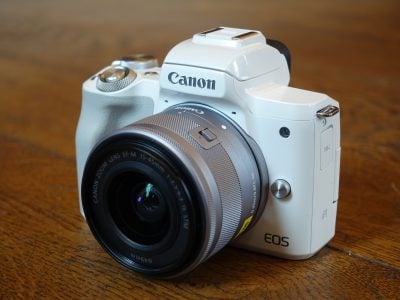Canon EOS M50 review
-
-
Written by Gordon Laing
Intro
The Canon EOS M50 is a mid-range mirrorless camera with a 24 Megapixel APSC sensor, viewfinder, fully-articulated screen and 4k video. Announced in February 2018, it’s officially pitched between the entry-level EOS M100 and the step-up EOS M6, but actually sports some of the most advanced features in the series: it’s the first Canon mirrorless to boast 4k video and a side-hinged screen that can flip to any angle. Coupled with a hotshoe and microphone input, the M50 is likely to be as popular with vloggers as it is with those looking for an upgrade from smartphone photography.
Like earlier models in the series, the M50 employs a 24 Megapixel APSC sensor with Dual Pixel CMOS AF for smooth and confident refocusing, but depending on the lens you fit, Canon’s upgraded the autofocus area and or the number of AF points. The EOS M50 also debuts Canon’s latest DIGIC 8 processor, allowing a slight boost in continuous shooting (10fps with Single AF or 7.4fps with Servo AF), support for an additional compressed ‘C-RAW’ option that’s full resolution but around 40% smaller, eye detection, a new silent scene mode that employs an electronic shutter, and at last 4k video. Wrapping-up the specs are a 2.36 million dot OLED viewfinder, a fully-articulated 3in touchscreen that can flip to face the subject, and Wifi with NFC and Bluetooth, the latter providing seamless connectivity and GPS location tagging with your phone.
Canon may be pitching the M50 as a mid-range model, but if you can live without the greater physical controls of the top-end M5, I’d say the new features make the M50 the most compelling in the series to date and also a keen rival for Fujifilm’s XT20 and recent XA5, not to mention Sony’s A6300 and Panasonic’s Lumix G80 / G85. In my review I’ll find out how it measures-up and whether it’s Canon’s best mirrorless to date! I’ll start with two videos: a brief first-looks overview, followed by my in-depth review with Doug Kaye which is also available as an audio podcast below. After this, I’ve detailed a number of the key features and capabilities.
Check prices on the Canon EOS M50 at Amazon, B&H, Adorama, or Wex. Alternatively get yourself a copy of my In Camera book or treat me to a coffee! Thanks!
Check prices on the Canon EOS M50 at Amazon, B&H, Adorama, or Wex. Alternatively get yourself a copy of my In Camera book or treat me to a coffee! Thanks!
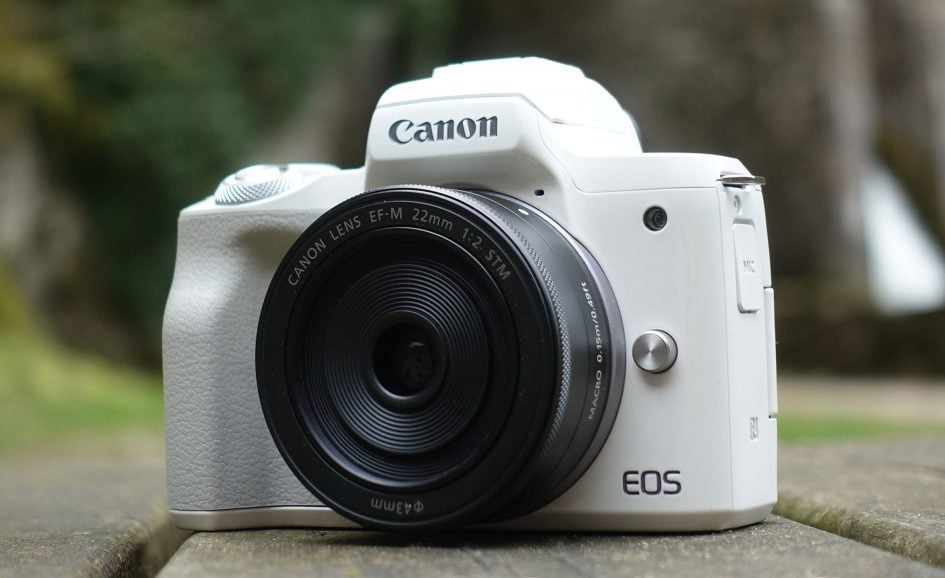
The EOS M50 is styled like a mini DSLR and available in black or white. It may have a fairly compact and light polycarbonate body measuring 116x88x59mm and weighing 390g with battery, but Canon’s designers should be commended on the ergonomics. The grip and rear thumb rest are generously-sized with a surface coating that ensures a secure and comfortable hold. Meanwhile there may only be one control dial – around the shutter release – but it falls naturally under your index finger. There’s also a small flash that’s raised by hand as well as a hotshoe that can accommodate external Speedlites or mount a microphone.
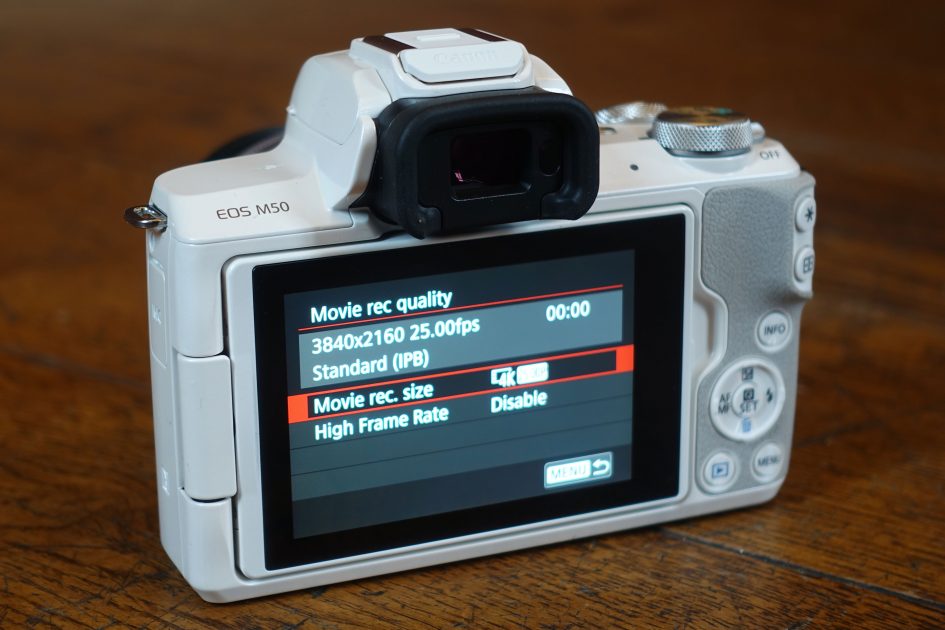
Round the back, the buttons are understandably small, but tiny raised edges on the four crosskeys makes them surprisingly tactile and easy to push; that said, I still found myself trying to turn a rear wheel that wasn’t there. Remember this is an upper entry-level camera with one control dial. Luckily the touchscreen features an excellent user interface.
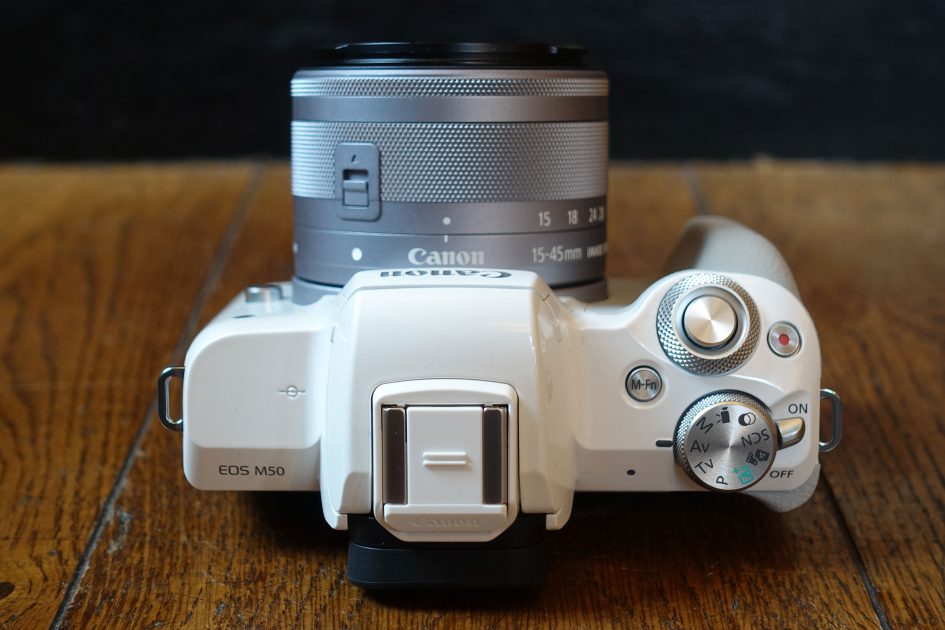
The EOS M50 becomes Canon’s second mirrorless camera to feature a built-in electronic viewfinder. The image isn’t huge, but the 2.36 Million dot OLED panel driving it is crisp and detailed. Like all electronic viewfinders you can deploy all manner of shooting assistance including, on the M50, a live histogram, dual-axis leveling gauge, a variety of alignment grids, focus peaking and magnification, as well as being able to film and playback video; no zebra patterns though.
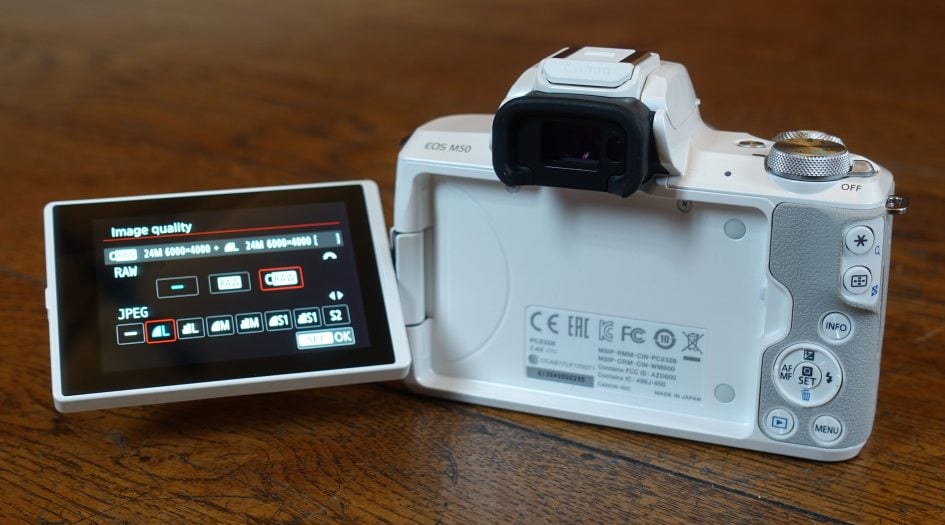
The EOS M50 is equipped with a 3in / 3:2 shaped touchscreen with 1040k dots. It inherits Canon’s excellent touch user interface which lets you intuitively tap your way through virtually every menu or setting, as well as pinching, pushing and swiping your way through playback. Suffice it to say you can tap to refocus for stills or movies, and also use it as an AF area touchpad while composing through the viewfinder. What makes the EOS M50’s screen really special though is that it’s the first on a Canon mirrorless to be side-hinged and fully-articulated, flipping to almost any angle including forward to face the subject for selfies or vlogging. It also means you can comfortably compose at high or low angles when shooting in the portrait / tall orientation.
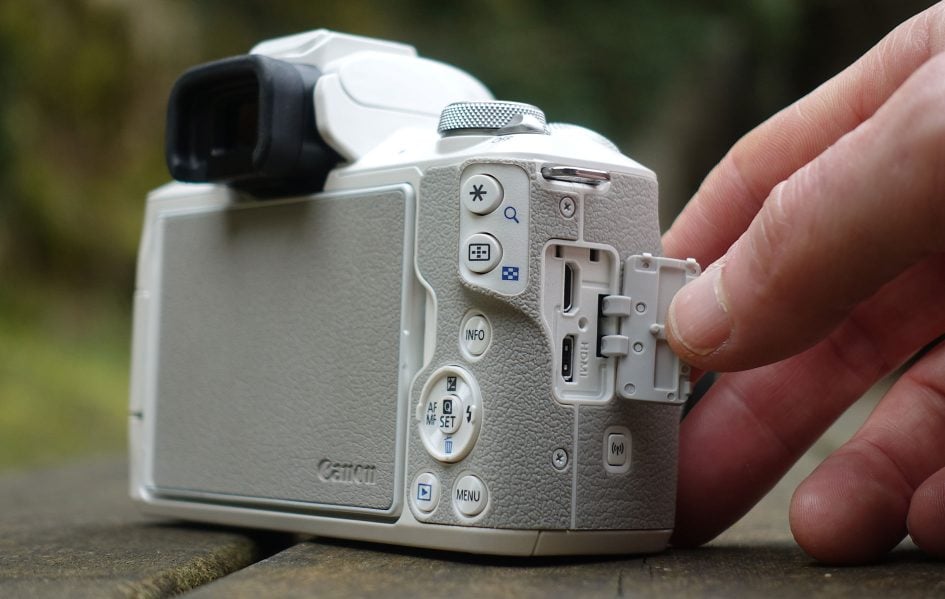
The EOS M50 is equipped with Micro USB and Micro HDMI (Type-D) ports, the latter outputting a 1080p signal that can be clean so long as you’re not recording video at the time. In one of the M50’s biggest downsides though, the USB port cannot be used to charge the camera. Instead you’ll need to use the supplied AC charger and find an outlet to connect it. I know this is no different from other Canon mirrorless cameras to date, but the fairly modest battery life of the M50 coupled with the inability to topup over USB while out and about caught me out on several occasions. The moral? Buy a spare battery and remember to recharge every night. In terms of battery life, I typically managed around 150 shots per charge in general-use including a few minutes of video and wifi use; for video alone, I recorded just over three consecutive half hour clips of 4k on a single charge with no overheating issues. Be warned though, the battery indicator can rapidly fall from half-way to flashing red. On the upside, the M50 does at least feature an external 3.5mm microphone input, allowing you to upgrade the quality of your audio – a key benefit for vloggers. I used it with my Rode Video Mic Pro, although I should add the quality from the built-in mics was also pretty good.

Like all Canon mirrorless cameras to date, the EOS M50 is equipped with an EF-M mount for use with native EF-M mirrorless lenses; with an APSC sensor, all lenses have their field-of-view reduced by 1.6 times, so the standard EF-M 15-45mm kit zoom delivers an equivalent coverage of 24-72mm; I’ve pictured its coverage above.

The f3.5-6.3 focal ratio of the EF-M 15-45mm, like most kit zooms, is only capable of minor blurring if you’re into shallow depth-of-field effects. Here’s a couple of examples at 15mm f3.5 (left) and 45mm f6.3 (right). If you want greater blurring, you’ll need a different lens.
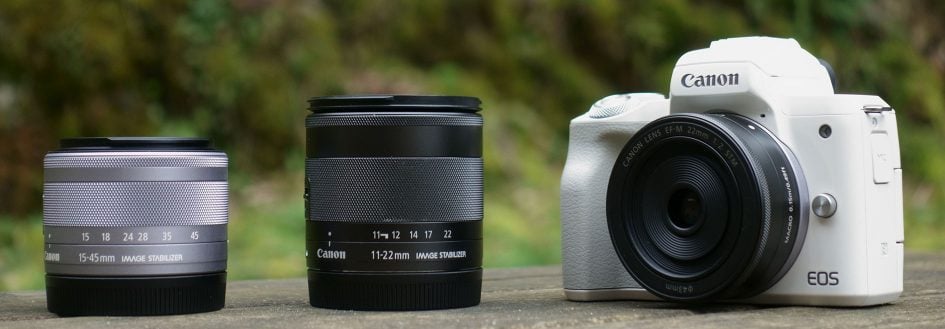
At the time of writing in April 2018, there were only seven native EF-M lenses, five of which are zooms and three of those are general-purpose models. Ultra-wide fans are catered by the EF-M 11-22mm, while telephoto photographers can go for the EF-M 55-200mm. If you’re into prime lenses, there’s the EF-M 22mm f2 and the EF-M 28mm f3.5 Macro, but sadly nothing in the standard 50mm or 85mm equivalent length with a nice bright aperture to deliver shallow depth-of-field effects. I’ve pictured the M50 above on the right fitted with the EF-M 22mm, with the EF-M 11-22mm in the middle and the EF-M 15-45mm kit zoom on the far left.
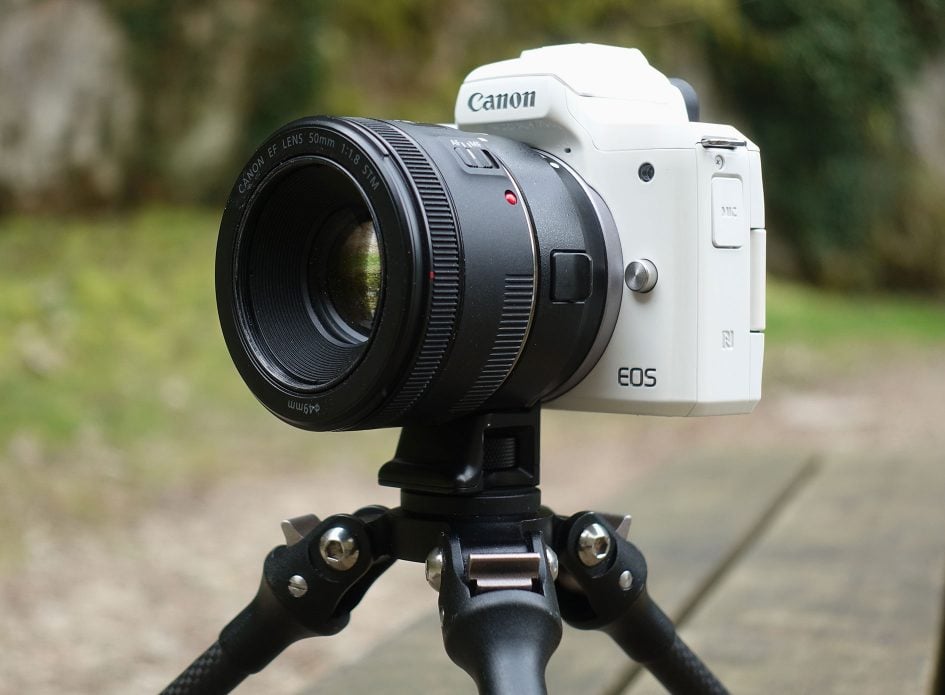
Canon’s solution to the currently modest selection of native mirrorless lenses is the EF to EF-M adapter which lets you mount any of the EF or EF-S lenses available, and it includes a built-in tripod foot to help balance larger models; I’ve pictured it here with the EF 50mm f1.8 STM lens, mounted on my Feisol TT-15 mini tripod. Adapted EF / EF-S lenses work very well on the M50, with full support for autofocus and tracking; the only issue is they’re inevitably larger and heavier than strictly necessary, and the adapter itself adds to the overall size of the package. So while it’s a useful capability for owners of existing Canon DSLR lenses, I’d still like to see more native EF-M lenses exploiting the shorter flange to sensor distance and only needing to be corrected for APSC.

The benefit of the EF to EF-M adapter is opening up access to the broad EF lens catalogue. Above are two portraits taken with the M50: on the left with the EF-M 15-45mm at 45mm f5.6 and on the right, the EF 50mm f1.8 STM at f1.8. Clearly the latter has the ability to deliver a much shallower depth of field and, coupled with the field-reduction from the APSC sensor, makes an ideal option for portraits; see my Canon EF 50mm f1.8 STM review for more details.
Like earlier models in the series, the M50 employs a 24 Megapixel APSC sensor with Dual Pixel CMOS AF for smooth and confident refocusing, but depending on the lens you fit, Canon’s upgraded the autofocus area and or the number of AF points. The previous Dual Pixel CMOS AF system covered roughly 80% horizontally and vertically, dividing the area into 49 points. Now when using the EF-M 15-45mm, EF-M 11-22mm, EF-M 18-55mm and EF-M 22mm, the area remains the same but the number of points doubles to 99. Fit the EF-M 28mm Macro, EF-M 18-150mm or EF-M 55-200mm (not to mention most adapted EF-S or EF lenses), and the points increase further to 143 spread across a broader area that covers 88% horizontally and a full 100% vertically. Disappointingly the EF-M 15-45mm kit zoom that’ll most commonly be used with the M50 isn’t one of those lenses that supports all the autofocus upgrades. But it still enjoys 99 AF points over an area 80% of the sensor width and height. I’ll talk more about the AF experience later in the review. If you prefer manual focusing, the EOS M50 also offers focus peaking assistance.

New to the EOS M50, thanks to DIGIC 8, is eye detection, amazingly another first for a Canon camera. This can be enabled if you have face detection already activated, after which the camera will seek out the closest human eye and focus on it; note Canon suggested at the launch that it might recognize non-human eyes, but it failed to do so on the dogs I pointed it at. Unlike Sony’s mirrorless cameras, eye detection on the M50 won’t work with continuous autofocus, but at least it’s now available as a first step. I took the portrait above using the EF-M 22mm f2 at f2.
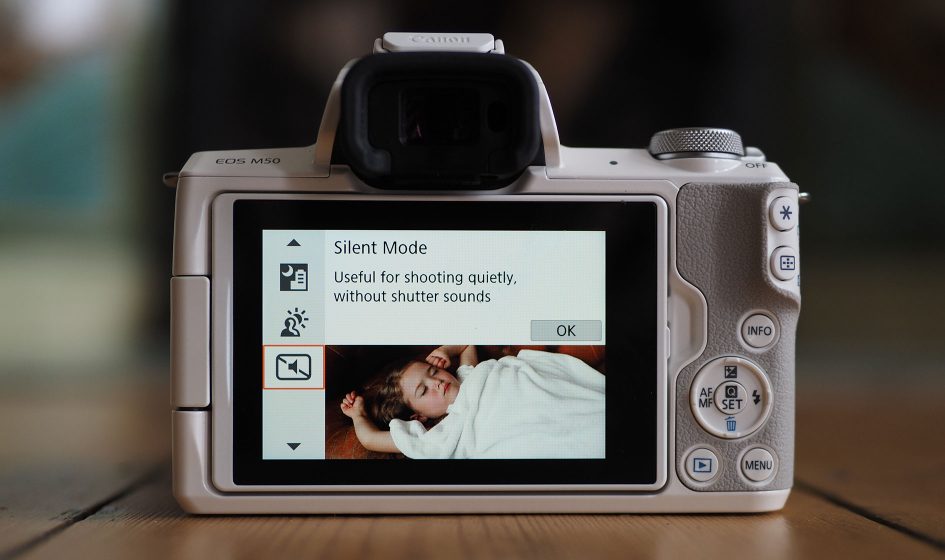
In another first for a Canon, the M50 now offers a Silent Mode that employs an electronic shutter to operate without any sound at all. It’s deployed via a SCN preset though which means it’s automatic exposure only, and sadly it doesn’t support continuous autofocus (as you’re shooting), burst shooting or eye-detection, nor does it extend the range of shutter speeds either, although at least there is the option to still record in RAW if desired. As such the silent mode is fairly basic on the M50, especially compared to rivals who’ve offered electronic shutter options for some time. But again at least it’s now available, and another benefit of DIGIC 8.
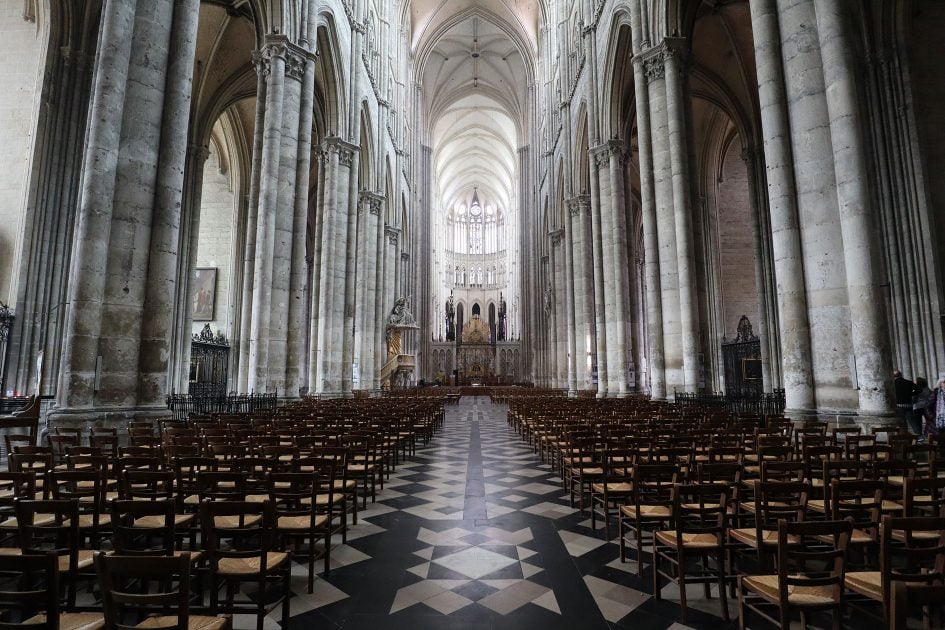
The Silent Mode is ideal for quiet environments like this shot I took inside Amiens Cathedral with the EF-M 11-22mm; it’s so nice to take photos without any sound in these situations.
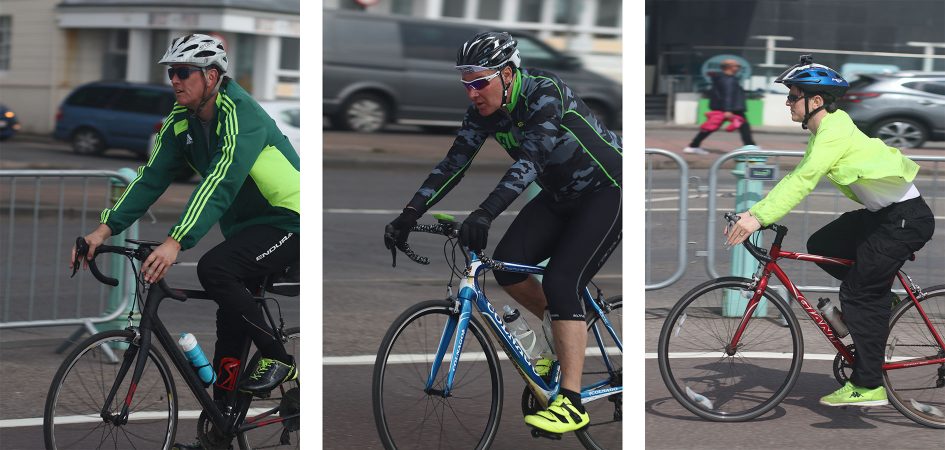
You may wonder why you wouldn’t use electronic shutters all of the time. Well apart from the fact the EOS M50’s Silent Mode limits your control over exposure and focus, there’s the issue shared with most cameras where relatively slow sensor readout means any subjects – or backgrounds – in motion can become skewed. In the three examples above, I was panning the camera to follow the action while taking the photo. In normal exposure modes, there’s no problem but when using the electronic shutter in Silent Mode, the background has become horizontally stretched due to the sensor readout. In more extreme cases, vertical lines like streetlights appear to be leaning diagonally. Again to be fair this is an issue that faces most electronic shutters so it’s not a criticism of the M50 alone, but remains an important issue to be aware of.
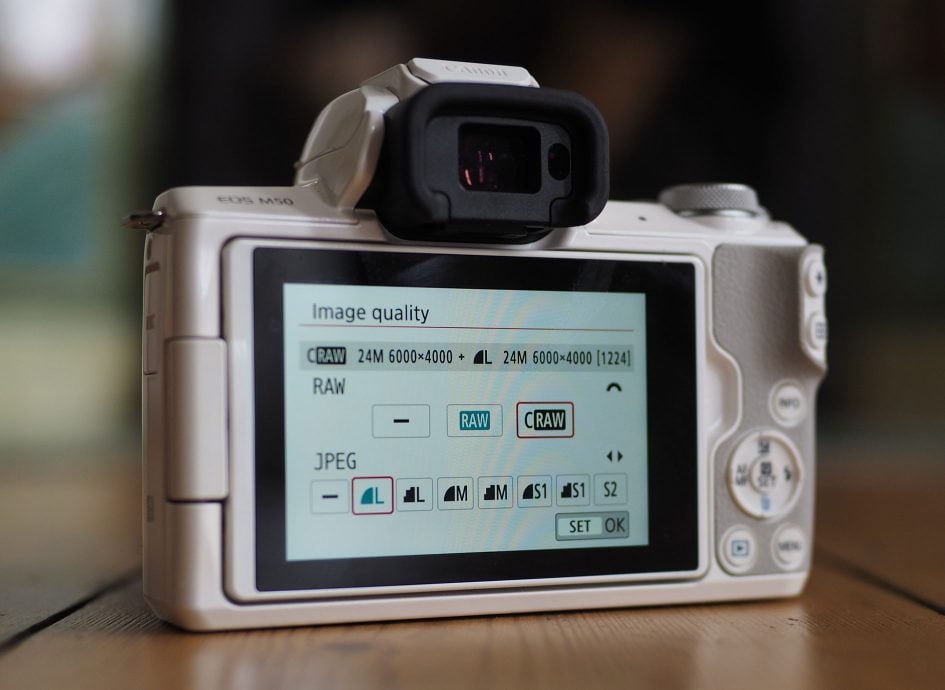
DIGIC 8 finally brings a compressed RAW option. The M50’s C-RAW mode captures full resolution images but compresses their size by around 40%, thereby giving you the flexibility of post-processing without consuming as much space on your card. Typically my standard RAW files on the M50 measured around 33MB, compared to around 22MB for C-RAW versions of the same composition. Meanwhile, the standard RAW files employ a new CR3 format so you’ll need to update your processing software unless you’re using Canon’s own supplied applications; alternatively the M50 supports in-camera processing of RAW files in playback, allowing you to adjust the brightness, white balance, picture style, auto lighting optimizer, noise reduction, JPEG output quality, lens corrections and colour space.



Turn the mode dial to Creative Filters and you can apply Grainy B&W, Soft Focus, Fish-eye, Water Painting, Toy Camera, Miniature or four different HDR effects. Most allow you to adjust the intensity of the effect, although the end result is only saved as a JPEG. You can however apply any of the effects to existing JPEGs using the Q menu in playback, so if you’re not 100% committed to an effect you could always shoot a normal version and make alternatives in playback later. If you’re into movies, you can apply an optional miniature effect to video too, albeit only in 1080 / 25p / 30p. Sadly though there’s still no panorama function on the M50, not even panorama assistance.
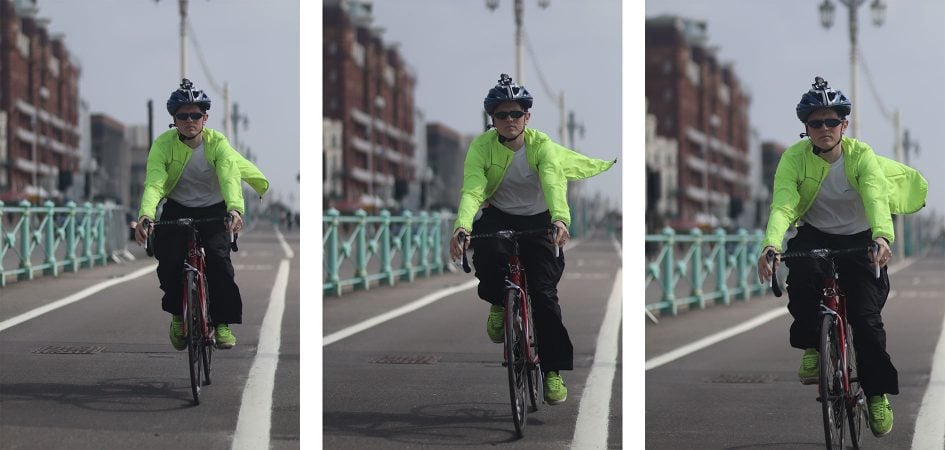
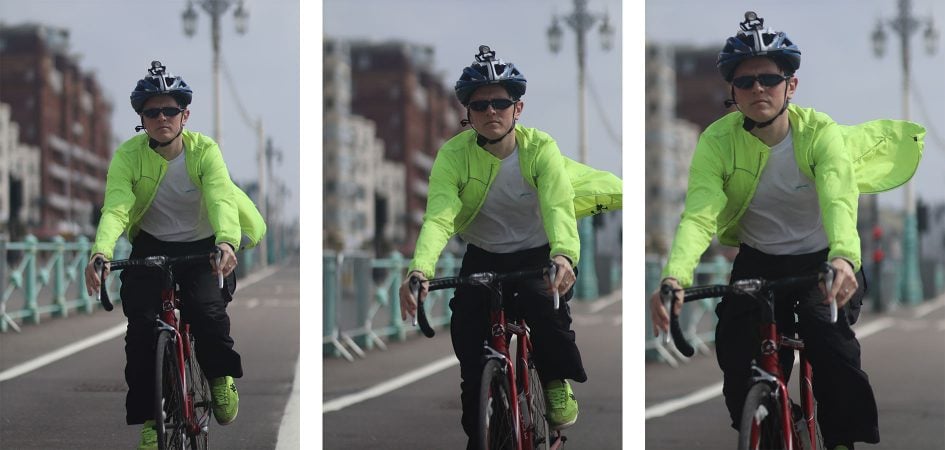
DIGIC 8 allows the EOS M50 to shoot bursts at up to 10fps with single AF or up to 7.4fps with continuous AF. I tried shooting my friend Ben cycling towards me with the M50 fitted with the EF 85mm f1.8 at f1.8. Of the three AF modes available, I found Zoned area the least effective for an approaching cyclist. The single AF area proved most effective so long as you could keep it positioned over the subject – something that can be tricky with the small delay between shots in the viewfinder. The tracking or face detect AF mode could also prove effective, but the former requires you to tap on or select the desired subject which can also prove difficult when they’re in motion and you’re using a longer focal length. At the top speed I also managed 88 Large JPEGs or nine RAW frames with continuous AF before the camera paused. That said, I still managed to grab useful focused sequences above 7fps and there’s a selection above.
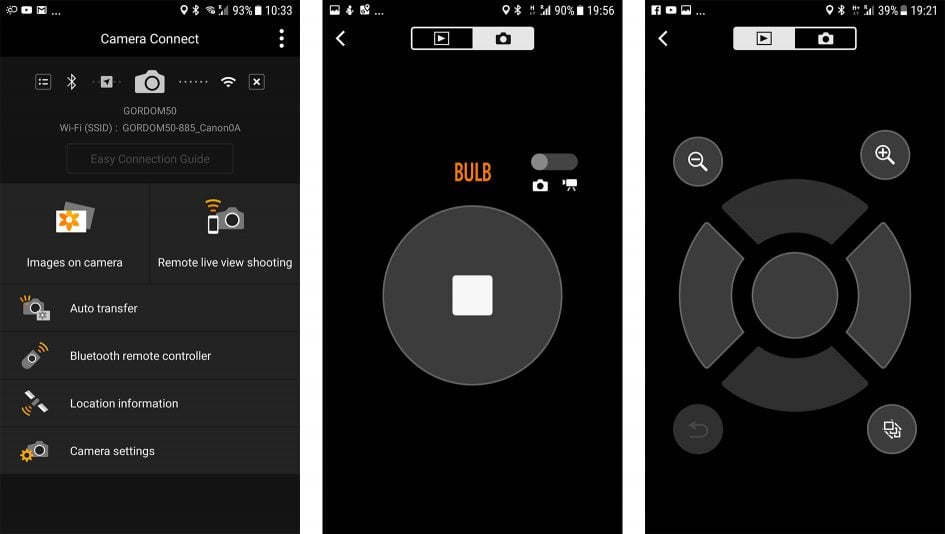
The EOS M50 is equipped with Wifi, complemented by NFC and Bluetooth to aid the connection. Canon’s wireless implementation is one of the best around, with Bluetooth maintaining a low power link between your phone and camera, seamlessly geo-tagging images (if desired) and offering an instant remote shutter control.
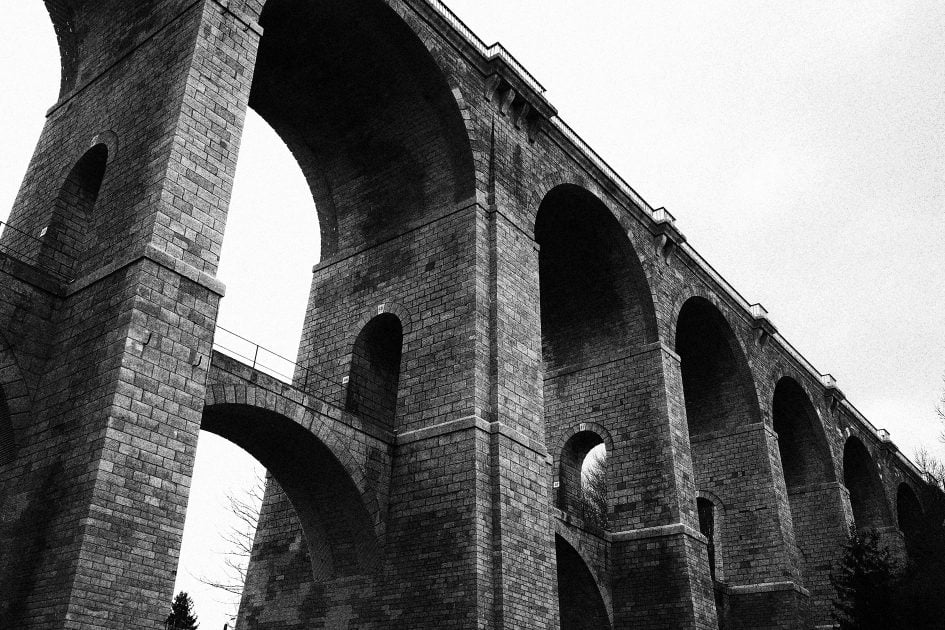
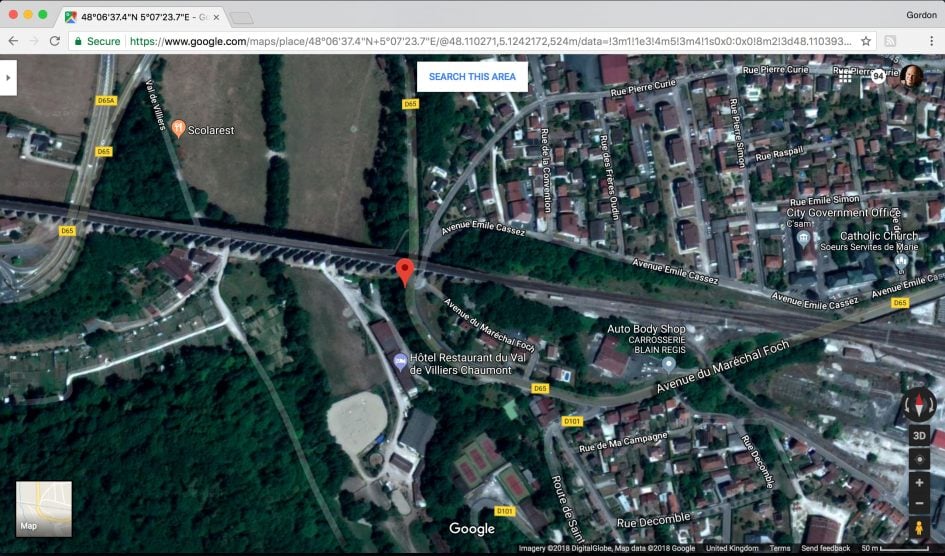
With your M50 paired with your phone over Bluetooth, you can set them up to automatically geo-tag images as you shoot without any interaction; all you need to do is ensure the Canon app is running on your phone, after which you’ll see a GPS icon appear on the camera’s screen moments after powering it up. I used it to geo-tag most of the images in my samples gallery. Here’s one with the location entered into Google maps.
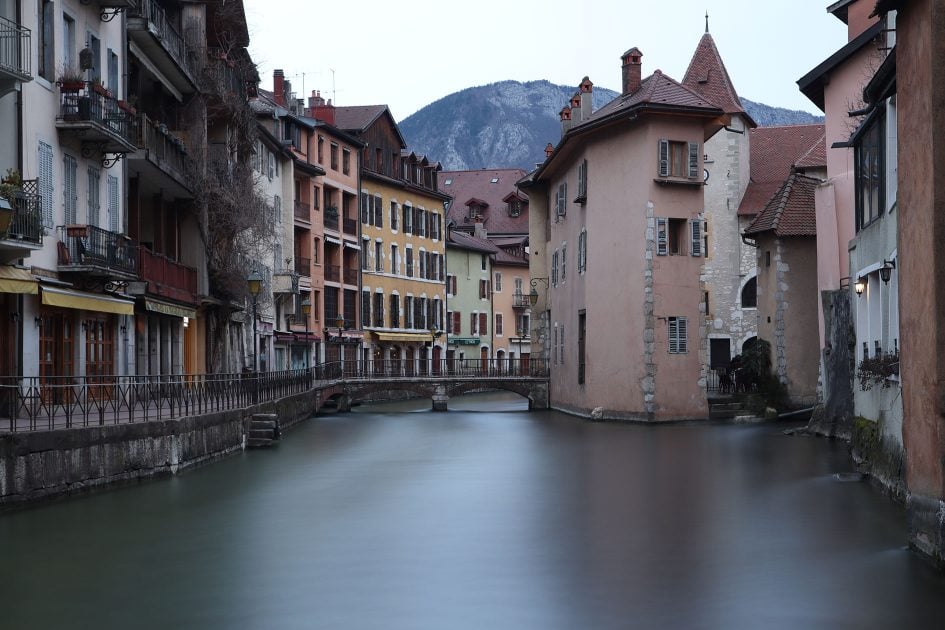
The Canon app also offers a simple Bluetooth remote control which works like a basic cable release. This lets you remotely trigger the shutter for stills or movies, as well as keeping it open for Bulb long exposures. I used it above to keep the shutter open for two minutes. Bluetooth’s speed means there may be no live image or exposure control in this mode, but the connection is instant with no lag, nor any delay with a Wifi connection. If you prefer full remote control though, that’s also available over Wifi.
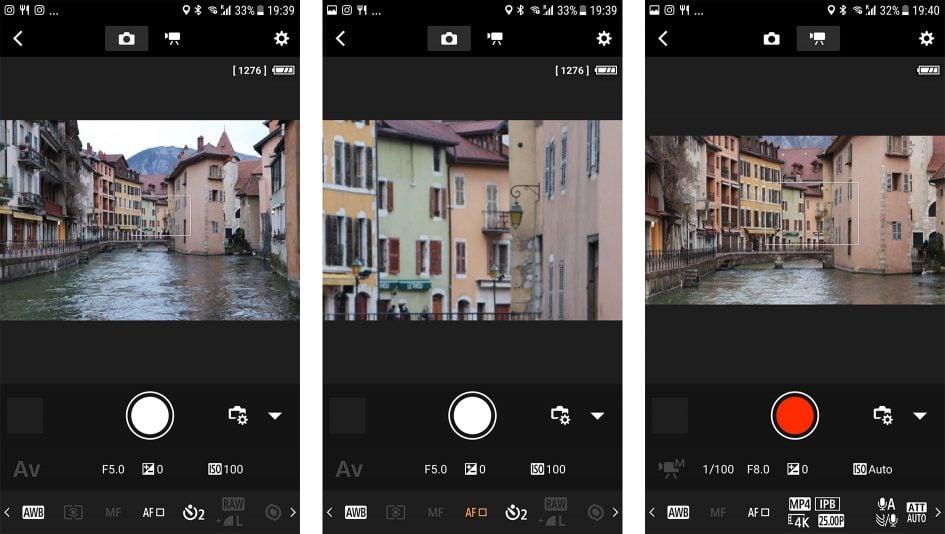
Bluetooth can also sort out the Wifi connection for you for browsing and copying images or offering a full remote experience with exposure and focus control and a live image.
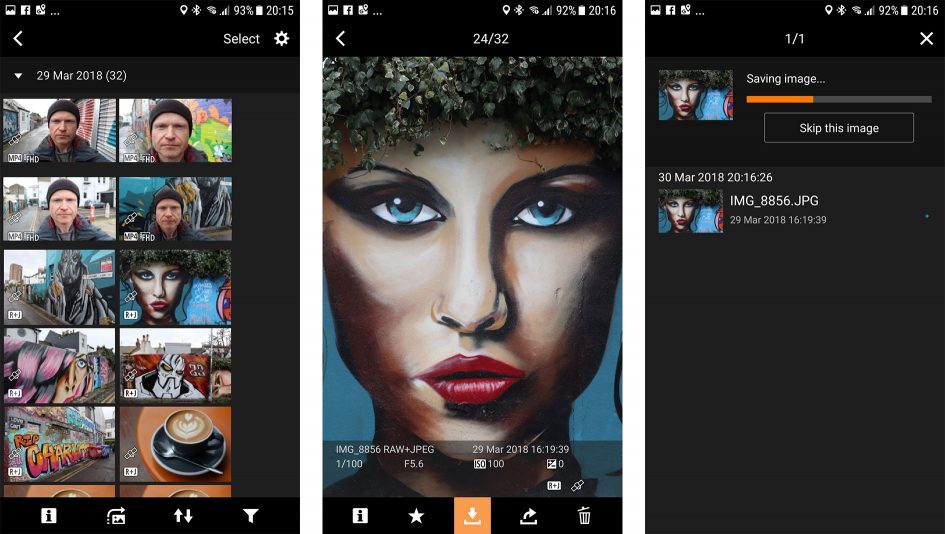
Just tap Images on Camera or Remote Live Shooting and the app will use Bluetooth to enable Wifi on the phone and camera, and take care of connecting them for you. It’s completely seamless and works a treat. You can even set the app to automatically transfer images to your phone as you take them, or sync them onto a computer once the camera’s connected to the same Wifi network. It’s also possible to configure the camera to maintain a Bluetooth connection when it’s switched-off, allowing you to remotely access the camera with your phone and copy images over, even if the camera itself is powered-off and stored in your bag; I did this numerous times to access and post images without having to even take the M50 out of my backpack.
Canon EOS M50 movie mode
The EOS M50 can film 720 video at 50 or 60p, 1080 video at 24, 25, 30, 50 or 60p, and in a first for a Canon mirrorless (or indeed any of their consumer models), 4k UHD at 24 or 25p. You can film for a second shy of half an hour in any of these modes and I didn’t experience any over-heating issues. In terms of battery life, I managed just over three consecutive half hour clips in 4k / 25p. In the video below I’ll detail the movie mode and compare the quality and AF performance between the 4k and 1080p modes.
Above: Download the original file (Registered members of Vimeo only). I also have a version filmed in 1080p.
There’s also slow motion available in 720p at 100 or 120fps, depending on region, interpreted in-camera to 25 or 30p for a four times slowdown. Note there’s no audio recorded nor autofocus available in this mode.
Above: Download the original file (Registered members of Vimeo only). I also have a version filmed in 1080p.
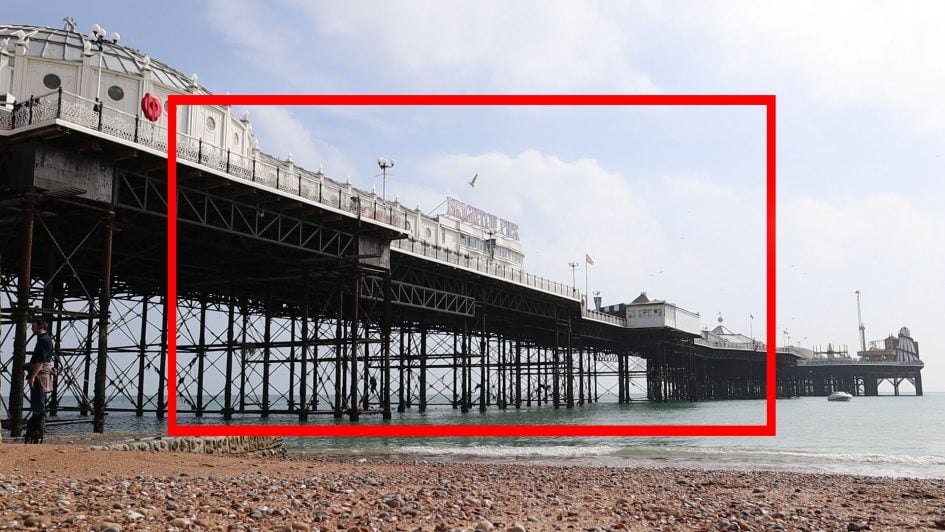
Video filmed in 720p and 1080p uses the full sensor width with no reduction in the horizontal field of view (even in 720 slow motion), but 4k takes a 1:1 crop from the middle of the frame, resulting in a 1.56x reduction; this in turn means it’s hard to film wide-angle in 4k, while the tight crop makes the M50’s 4k mode more susceptible to rolling shutter artefacts. In the image above, the outer edge of the red frame indicates the coverage of 4k compared to 1080 when using the same lens.
If you film in 720p or 1080p, the M50 can deploy Dual Pixel CMOS AF for smooth and confident refocusing without hunting. Sadly Dual Pixel CMOS AF is not available in 4k though, with the M50 reverting to a contrast-based autofocus system that’s less confident with more visible hunting.
Above: Download the original file (Registered members of Vimeo only). I also have a version filmed in 1080p.
As such, 4k on the M50 is of limited use compared to the 1080 and 720 modes: the severe crop and susceptibility to rolling shutter coupled with basic autofocus means it’s best-suited to tripod-based clips that don’t need wide-angle coverage. That said, if the conditions are favourable, the M50’s 4k footage can certainly look good, but it’s not up to the quality or usability of 4k on models like Sony’s A6300 or the Lumix G80 / G85. Even Fujifilm’s XT20 with its 10 minute clip limits proves more flexible overall for 4k. So it’s best to consider the M50 mostly as a 1080 camera, at which it’s fortunately very good.
Vloggers in particular will love the M50 for its combination of a decent-sized APSC sensor, excellent autofocus and face detection (at least for 1080p), microphone input and side-hinged touchscreen which can flip to face the subject. That said, I found the M50’s built-in mics were already pretty good. I’ve put together a vlogging demo in 1080p above.
The M50 also offers additional digital stabilisation for movies with standard and enhanced modes taking gradually tighter crops in order to have some padding around the edges to work with. Enabling digital stabilisation can certainly smooth-out some wobbles, and the enhanced mode even more so, but each comes at the cost not just of a tighter field-of-view, but also reduced quality due to the pixel-wrangling.
4k video in particular suffers the most as the M50 already starts with a 1:1 crop when there’s no digital stabilisation, so taking a further crop means capturing less than 4k resolution and scaling it up. Then there’s the impact of the additional crop: in 4k, you’re looking at 1.56x without digital IS, 1.75x with digital IS and a whopping 2.2x with the enhanced mode, all on top of the sensor’s 1.6x thanks to its APSC size. So even with the widest EF-M 11-22mm zoom at 11mm, filming in 4k on the M50 will transform it into a 28mm equivalent without digital IS, and 31mm or 39mm with digital IS or enhanced IS respectively. Meanwhile the EF-M 15-45mm kit zoom at 15mm becomes over 50mm equivalent in 4k with enhanced stabilisation.
Above: Download the original file (Registered members of Vimeo only).
Finally, the M50 offers timelapse video facilities with the option to encode the result in 1080p or 4k. There’s three preset scenes designed for capturing subjects like people walking or clouds in a sky, or you can enter custom settings. Above is an example I filmed using the first scene, capturing 300 images at three second intervals; I used the EF 85mm f1.8 here for a compressed perspective and shallow depth-of-field.
Canon EOS M50 quality
Now it’s time to take a closer look at the photo quality of the M50, starting with my quality page which shows how the camera performs across its ISO sensitivity range in JPEG and RAW. Then check out my sample images, taken with a variety of lenses, before heading to my verdict page!
Check prices on the Canon EOS M50 at Amazon, B&H, Adorama, or Wex. Alternatively get yourself a copy of my In Camera book or treat me to a coffee! Thanks!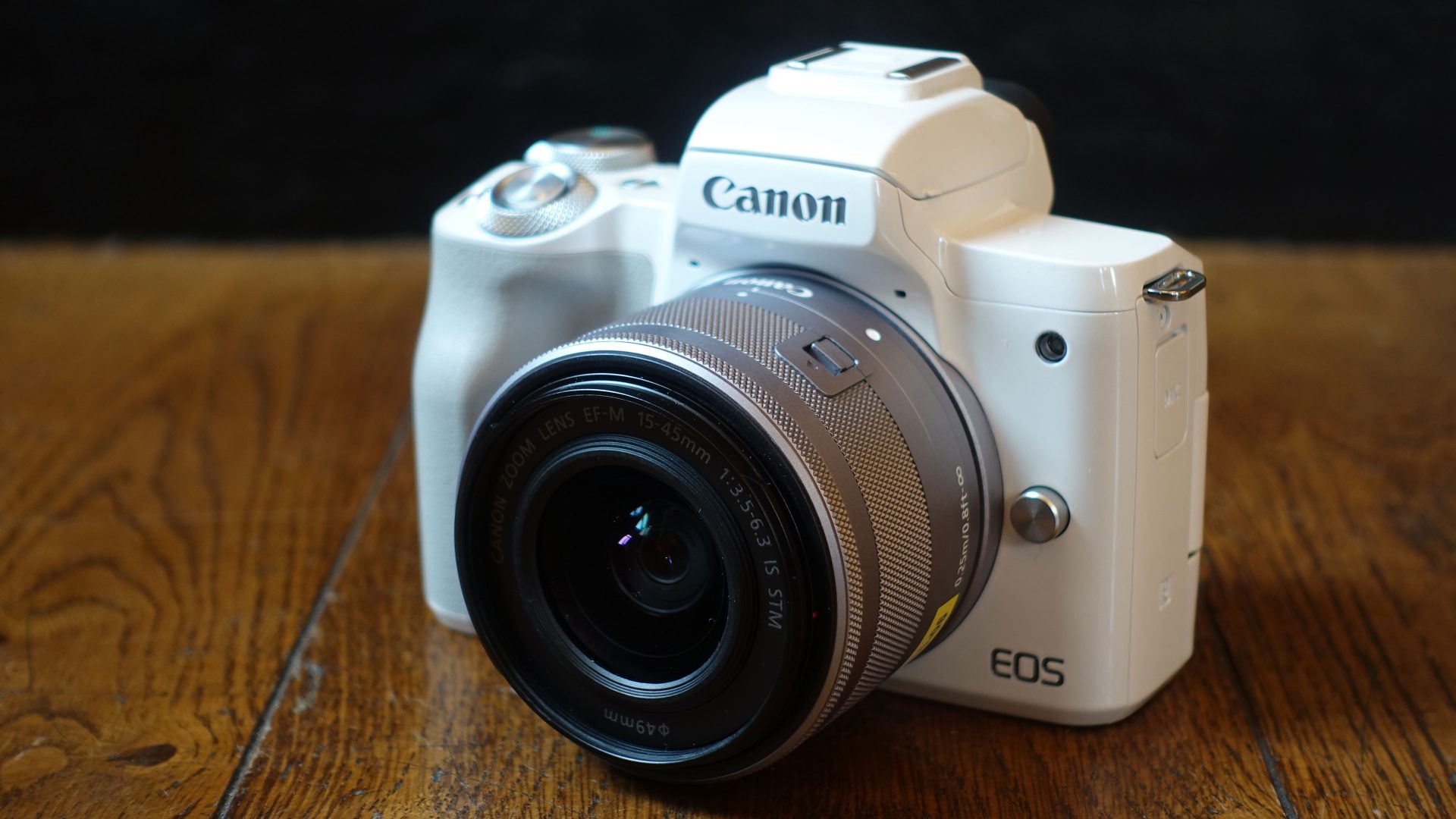
 The Canon EOS M50 is an upper entry-level mirrorless camera with a 24 Megapixel APSC sensor, confident autofocus (for stills and 1080p video), small but crisp OLED viewfinder, excellent wireless, and becomes Canon's first mirrorless with 4k video, a fully-articulated touch-screen, eye detection and silent shooting options. Sadly the 4k is of limited use, employing a severe crop and only working with less confident contrast-based autofocus. I'm also frustrated there's no USB charging, especially since the battery is fairly weak. But these aside, the EOS M50 remains a highly compelling model with a compact but comfortable body, effective touchscreen, industry-leading wireless, confident focusing for 1080p video, and great colours out-of-camera. Indeed the M50 may be pitched as an upper entry-level model, but I reckon it's Canon's most compelling mirrorless to date. Coupled with a hotshoe and microphone input, the M50 will be as popular with vloggers as it is with those looking for an upgrade from smartphone photography. Recommended.
The Canon EOS M50 is an upper entry-level mirrorless camera with a 24 Megapixel APSC sensor, confident autofocus (for stills and 1080p video), small but crisp OLED viewfinder, excellent wireless, and becomes Canon's first mirrorless with 4k video, a fully-articulated touch-screen, eye detection and silent shooting options. Sadly the 4k is of limited use, employing a severe crop and only working with less confident contrast-based autofocus. I'm also frustrated there's no USB charging, especially since the battery is fairly weak. But these aside, the EOS M50 remains a highly compelling model with a compact but comfortable body, effective touchscreen, industry-leading wireless, confident focusing for 1080p video, and great colours out-of-camera. Indeed the M50 may be pitched as an upper entry-level model, but I reckon it's Canon's most compelling mirrorless to date. Coupled with a hotshoe and microphone input, the M50 will be as popular with vloggers as it is with those looking for an upgrade from smartphone photography. Recommended.



